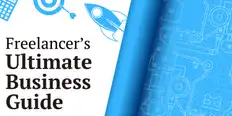“15 years in the ad industry taught me how to work successfully with freelancers”
Learn exactly how to work efficiently and effectively with freelancers - from an account director's perspective.
14.05.2021 • 8 Min. Lesezeit
Aktualisiert am 20.05.2021 von Francesco S.

Content creator - writing and photography
Das Kopieren in der Zwischenablage ist fehlergeschlagen, bitte nach Anpassung Ihrer Berechtigungen erneut versuchen.
In der Zwischenablage kopiert.
As an advertising account director turned independent content creator, I have experienced the client-freelancer relationship on both sides of the fence.
It’s a dynamic full of advantages and rewards if approached correctly from the beginning. However, when both parties don’t invest in the process, the experience can end up being challenging.
An I'm here to help you avoid that. So if you're considering hiring a freelancer for the first time or you've had a less-than-ideal experience in the past, this article is for you.
Because there are many opportunities offered by the freelance revolution , and we want you to take full advantage of it.
In the 15 years I worked in advertising, I’ve experienced two major challenges with hiring and working with freelancers. I'll explain those before providing 7 steps to avoiding these challenges, so that you can form successful and fruitful relationship with freelance workers.
Challenge #1 - not choosing the right freelancer for the job
The mistake many marketers often make is to hire just a designer, a writer, a developer, etc. For each discipline, they don’t search for a specific set of skills or experience necessary to deliver that particular job.
Let’s take design, for example. You can choose between
Designers can have experience in a few of those categories, but there will be one or two where they excel. Their levels of experience vary as do their approaches to design: from the more creative and innovative to the more “corporate” or conservative.
Sometimes the hirer overlooks communication abilities and other soft skills, which are crucial to consider, especially for complex and long-term projects.

To draw a parallel from a different industry, think of hiring a chef who works in a steak restaurant to make your wedding cake.
Being a chef, he knows his way in the kitchen and he’d know how to bake. However, would his cake be as good as the one prepared by a pastry chef who has made cakes for newlyweds for the last twenty years?
Related to this is not assigning the right price tag to the right freelancer. This goes beyond not paying people what they’re worth.
To illustrate this, let’s go back to our pastry chef example. We could set a modest, but still adequate budget for an up-and-coming pastry chef whose inventive cakes have generated lots of noise on social media.
His career is in its early days and, at this stage, he’s interested in proving himself and showing the quality of his work. This means our budget could be enough for him to guarantee the result we seek.
The same amount instead would not be enough for a high-end pastry chef with over twenty years of experience. He would either turn the job down, or accept it but dedicate less attention and energy compared to higher-paid jobs.
The responsibility of not choosing the right freelancers normally falls on the hirers’ shoulders, as the ones seeking talent. However, the freelancer might also contribute to this; they might over-inflate their skills or capacity to deliver a certain project, motivated by filling in a hole in their schedule or adding a new project to their portfolio.
The company would find this out only at the end of the project and with great disappointment. They would see themselves forced to start the project all over again, or come to terms with a suboptimal result.
Problem #2 - not investing in relationships
This is a critical issue born from the misconception that freelance work is by nature short-term. Companies and agencies sometimes see freelancers as B-League workers purely because one day they’re in and the next day they’re out.
Both the hirer and the freelancer don’t invest time and energy in going through the brief, providing and absorbing the background information and communicating effectively.
While it requires effort, communicating effectively and building strong relationships directly impacts the quality of the work.
That's because:
It needs to be a two-way process. To make it a smooth process and avoid any pitfalls, both sides need to know how and when to ask (or provide) the right information.
To avoid any pitfalls, follow my hacks below. I refined them during my 15 years working in advertising. These tips will apply whether you work in a large organisation, an agency, or you’re a solopreneur hiring an independent talent.
7 Hacks to work successfully with freelancers

Working with freelancers offers some indisputable benefits, including:
But to make sure your organisation enjoys these benefits in full, you need to hack the freelancing process to your advantage.
Try these for yourself, dial them up or down, and then come up with the formula that best suits your style and your company’s ways of working.
1. Invest the time
Probably the biggest key of all is the way you approach time when working with freelancers.
To save time, you need to invest time.
Often the reason for hiring a freelancer is to support the company during peak workload, and time is limited in those instances.
However, the most effective approach is to font-load your time investment in the first phases of the process and then reduce it as you start seeing results.
Dedicating time to finding the right resource and setting them up for success will allow you to:
take a “hands-off approach” towards the end of the project
recoup precious time
avoid ending up with an incomplete or disappointing output
2. Look far and wide for the right talent
Ask around in your network or search on the online marketplaces. The freelance platforms are a great way to find talent that is outside of your circle and who have very specific skills.
For example, are you looking for a pen and ink illustrator?

Or maybe you need a vectorial illustration for a coffee cup...

Identifying a freelancer with specific abilities and a portfolio that is very close to the result you’re aiming for saves you time twice:
3. Assign the right budget
As mentioned in the introduction of this article, this goes beyond assigning a budget that is in line with the freelancer’s experience and skills.
There are ways to optimize a budget by assigning it to a worker who doesn’t have lots of experience, but shows incredible talent. You could also bundle your project with any future ones, which will be very enticing for a freelancer looking for repeat business.
Often your budget is non-negotiable, as it’s assigned by a manager or a client, but it’s in your best interest to find the sweet spot between the right price and the quality it allows you to access in the market.
4. Prepare a killer brief
The most experienced freelancers work autonomously, do their research and cover extensive ground to deliver their best work. However, there is some information they can only get from you .
When preparing a brief, don’t just go for the bare minimum, but provide any contextual information that can help gain a better understanding.
Paint the bigger picture and give stimulus to support the development of new ideas. Of course, you don’t want to overload them with research, data and details that are not relevant to them - try to find the balance between the two.
Also, make sure your written brief is always followed by a phone or video conversation to provide more background, stress the most important points and answer any questions the freelancer might have.
Take the time to walk them through the more complex aspects, like achieving the right tone of voice for a brand. Make sure you communicate upfront about how you (or your client) like to work and have the project presented - it can make or break a relationship!
5. Communicate clearly and often
Keep freelancers updated on the status of the project. It helps them manage their schedule so they can be available right when you need them.
Try to establish a good rapport. You want to become their dream client so that for the next project they’ll be more inclined to accept a tight budget or deadline and help you get out of sticky situations.
Give them honest and constructive feedback as if they were an employee. There are good chances they could turn into a resource you rely on often.
In other words, think of them as a staff member (but with the benefit of no overhead attached).
6. Make them part of the culture
Now, this is probably the most challenging hack to implement, especially when freelancers work remotely and cannot join the all-staff meetings, the announcements and the birthday celebrations.
The most successful companies know that having a strong culture is not just a way to attract and retain the best talent, but is also an important PR asset as it expresses the company personality beyond its offering and branding.
For an agency, a positive culture is possibly even more important. Clients use it as an indicator to gauge how easy it is to work with the agency.
There is a say in Adland: “An agency is as good as its people” and clients can quickly pick up if there is good chemistry between its team members. It comes to the fore in the slides of a presentation, in a meeting or just by looking at the agency’s final output.
So next time you hire a freelancer, think about any meetings or company events they could join.
I once freelanced as Group Account Director and after only 5 months working with the agency, I got invited to their Christmas party.
In his speech, one of the agency leaders said I managed to nicely blend in with the agency’s culture, but I also believe that they allowed me to do so from day one.
Thanks to their inclusive approach and the effort from both sides, we worked more effectively and delivered better outcomes for the clients.
6. Build long-term relationships
As per hack #4 and #5, it’s in your interest to build dependable relationships with freelancers.
You want to find the most talented, efficient and easy-to-work-with resources and keep working with them repeatedly. This helps you cut the talent research time entirely, shorten your briefing preparation and discussion, and simplify all other phases of the process.
Savvy freelancers will do whatever they can to keep working with you. They also want to spend less time getting to know a client and run the admin, and spend more time doing the work. After all, that’s one of the reasons why they’ve chosen the freelance path!
7. Reap the benefits
After you’ve planted the seeds and watered the plants, now is the time to reap the fruits of your investment.
The more projects you run with the same talent, the easier it gets. You’re both familiar with the ways you operate, you communicate smoothly, you’ve become a well-oiled machine.
Unlike full-time employees, freelancers are regularly in contact with other teams and organisations. This can be a great source of inspiration as they bring new ideas and approaches to the table.
Make sure you keep nurturing these relationships, by occasionally checking in with your freelancers and engaging them for future projects. This is where you’ll see the long-term return on your investment.
Conclusion
Sagen Sie uns, was erledigt werden soll
Projektnamen eingeben
Ähnliche Storys
Sprechen Sie mit einem unserer technischen Co-Piloten, der Sie bei Ihrem Projekt unterstützt
Für Sie empfohlene Artikel

Your search for the right freelancer doesn't have to be a mythical quest. Here are 7 steps to finding the best freelance worker for your needs.
10 min read

Statistics show the freelance economy is booming, so now's the time to bring fresh perspectives onto your team.
5 min read

Freelancers can be an incredible asset for startups. Learn how to manage them for maximum effectiveness
6 min read

Businesses will increasingly have to turn to teams of freelancers to get work done. We'll show you the best way to manage them.
7 min read
Danke! Wir haben Ihnen per E-Mail einen Link geschickt, über den Sie Ihr kostenloses Guthaben anfordern können.
Beim Senden Ihrer E-Mail ist ein Fehler aufgetreten. Bitte versuchen Sie es erneut.
Vorschau wird geladen
Erlaubnis zur Geolokalisierung erteilt.
Ihre Anmeldesitzung ist abgelaufen und Sie wurden abgemeldet. Bitte melden Sie sich erneut an.




